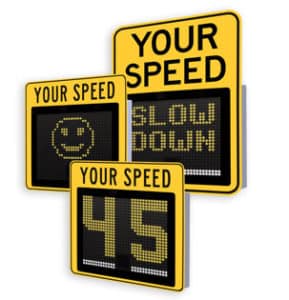Guest Post by Brett Ferrin, VP of Sales
When a municipal agency purchases a driver feedback sign, the goal is always to maximize the features of the sign so that it does exactly what it was intended to do: slow traffic down. Radar signs are +/- 1 mph in their accuracy when they’re programmed correctly. But in my role as VP of sales at Traffic Logix, when I travel around the country, rarely do I see radar signs that are programmed correctly.
traffic down. Radar signs are +/- 1 mph in their accuracy when they’re programmed correctly. But in my role as VP of sales at Traffic Logix, when I travel around the country, rarely do I see radar signs that are programmed correctly.
There is a strategic method to programming a radar sign to achieve the desired goal and not lose the effectiveness of the device. It’s unfortunate when a city or police department invests in radar signs and then fails to maximize their potential. Here are some tips on how to program a driver feedback sign correctly so your signs can do what you want them to.
How to Program Your Radar Sign
All radar signs have a setting to choose your tolerated speed range. Police departments generally give residents a few mph of cushion over the speed limit. This means that to maximize the effectiveness of the sign, you need to give drivers some leeway. It does not make sense to use all of the warning features of the sign at 1 mph over the speed limit. In that case, the driver’s speed may even be exactly what it should be since the signs are accurate +/- 1 mph. You should always give drivers a minimum of 3 mph before you program your sign to do anything besides simply displaying the speed.
Traffic Logix speed display signs offer a variety of interactive features such as strobe lights, flashing digits and even changeable messages. Ultimately these features become more effective in slowing down traffic if they’re used incrementally.
Here are some suggestions on effective ways to slow speeders using your radar sign settings:
- From the posted speed until 3-5 mph over the speed limit, simply display driver speed. If you are using your sign with positive reinforcement and have a model with custom messages and graphics, this would be the ranger where you’d choose to display a positive emoji or message.
- Once a driver is going faster than 3-5 mph, program your sign digits to flash so the driver understands they are travelling over the designated speed limit.
- At 8-10 mph over the speed limit, program the strobe light to flash to get the attention of the driver.
- Once a driver is going more than 10 mph over the speed limit, you should be programming the digits to flash, the strobe to go off, and based on the model and available features, the display color to change to red and the sign display to change to “SLOW DOWN,” “TOO FAST” or a custom message of your choice.
- Set an upper speed cutoff for the sign at 15-20 mph over the speed limit as well. Then the sign doesn’t become the high score solution for teenagers to try to achieve 99 mph. A changeable message sign could also display “TOO FAST” above the upper speed cutoff.

Drivers tend to drive at a comfortable pace. The wider the road, the higher the speed because drivers have less to navigate and are more comfortable that a child or animal unlikely to run into the road. Driver feedback signs are there to remind drivers of their speeds and encourage them to slow down. They are not there to punish drivers. The most effective way to get their attention is to let them know when they are driving above the desired speed. Certainly, we can be understanding that 3-5 mph over the speed limit in a 30 or 40 zone is still within acceptable parameters. The one exception would be in school zones. Children are unpredictable and less tolerance and stricter settings on your signs are certainly acceptable and expected under those circumstances.
If you would like assistance in programming your driver feedback signs or suggestions on how to increase the effectiveness of the radar signs in your neighborhoods, please contact us at info@trafficlogix.com. We are passionate about creating safer roads and here to help you as you work to protect your streets and everyone who uses them.







